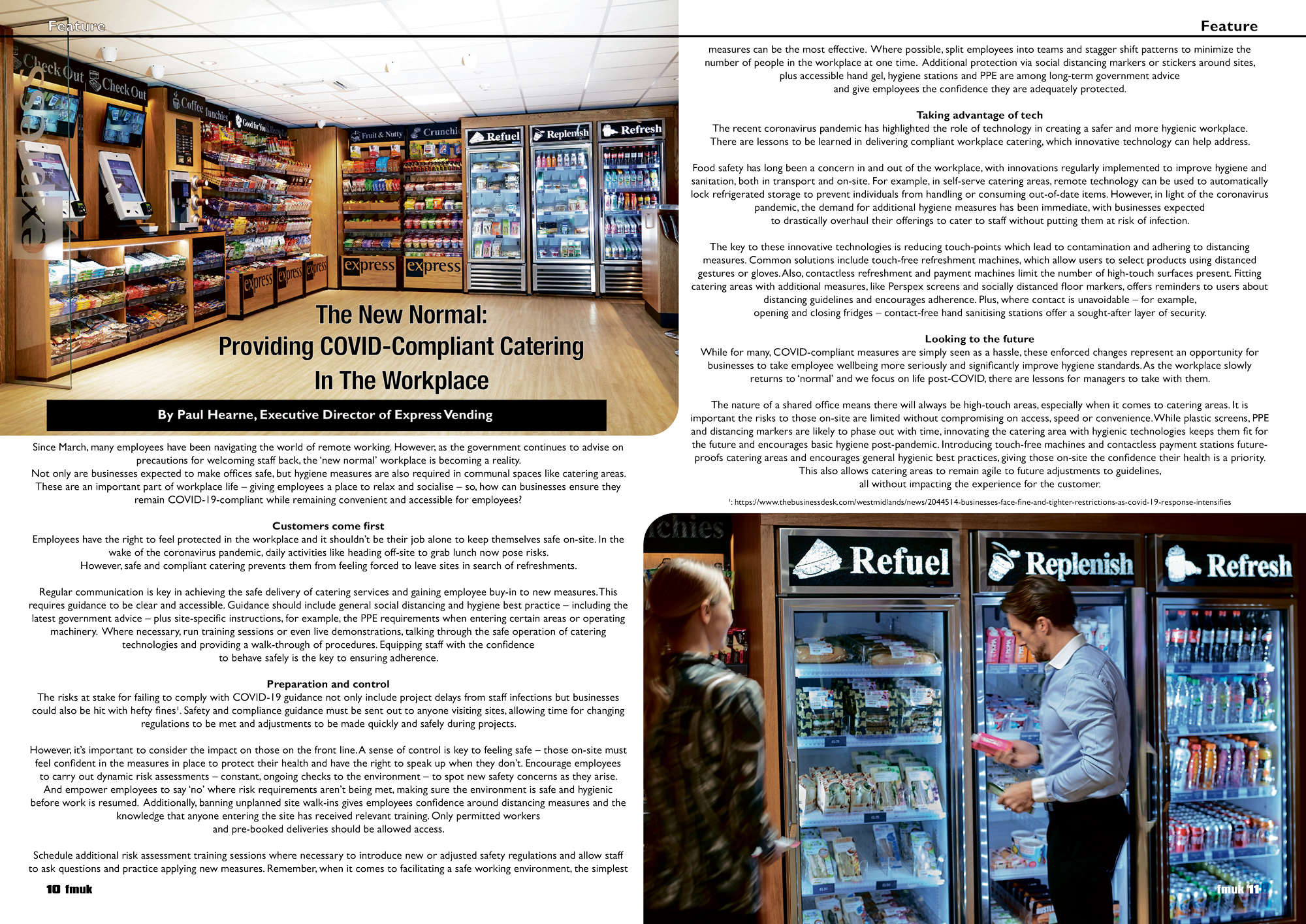The New Normal: Providing COVID-Compliant Catering In The Workplace
 By Paul Hearne, Executive Director of Express Vending
By Paul Hearne, Executive Director of Express Vending
Since March, many employees have been navigating the world of remote working. However, as the government continues to advise on precautions for welcoming staff back, the ‘new normal’ workplace is becoming a reality.
Not only are businesses expected to make offices safe, but hygiene measures are also required in communal spaces like catering areas. These are an important part of workplace life – giving employees a place to relax and socialise – so, how can businesses ensure they remain COVID-19-compliant while remaining convenient and accessible for employees?
Customers come first
Employees have the right to feel protected in the workplace and it shouldn’t be their job alone to keep themselves safe on-site.
In the wake of the coronavirus pandemic, daily activities like heading off-site to grab lunch now pose risks. However, safe and compliant catering prevents them from feeling forced to leave sites in search of refreshments.
Regular communication is key in achieving the safe delivery of catering services and gaining employee buy-in to new measures. This requires guidance to be clear and accessible.
Guidance should include general social distancing and hygiene best practice – including the latest government advice – plus site-specific instructions, for example, the PPE requirements when entering certain areas or operating machinery.
Where necessary, run training sessions or even live demonstrations, talking through the safe operation of catering technologies and providing a walk-through of procedures. Equipping staff with the confidence to behave safely is the key to ensuring adherence.
Preparation and control
The risks at stake for failing to comply with COVID-19 guidance not only include project delays from staff infections but businesses could also be hit with hefty fines.
Safety and compliance guidance must be sent out to anyone visiting sites, allowing time for changing regulations to be met and adjustments to be made quickly and safely during projects.
However, it’s important to consider the impact on those on the front line. A sense of control is key to feeling safe – those on-site must feel confident in the measures in place to protect their health and have the right to speak up when they don’t.
Encourage employees to carry out dynamic risk assessments – constant, ongoing checks to the environment – to spot new safety concerns as they arise. And empower employees to say ‘no’ where risk requirements aren’t being met, making sure the environment is safe and hygienic before work is resumed.
Additionally, banning unplanned site walk-ins gives employees confidence around distancing measures and the knowledge that anyone entering the site has received relevant training. Only permitted workers and pre-booked deliveries should be allowed access.
Schedule additional risk assessment training sessions where necessary to introduce new or adjusted safety regulations and allow staff to ask questions and practice applying new measures.
Remember, when it comes to facilitating a safe working environment, the simplest measures can be the most effective.
Where possible, split employees into teams and stagger shift patterns to minimize the number of people in the workplace at one time.
Additional protection via social distancing markers or stickers around sites, plus accessible hand gel, hygiene stations and PPE are among long-term government advice and give employees the confidence they are adequately protected.
Taking advantage of tech
The recent coronavirus pandemic has highlighted the role of technology in creating a safer and more hygienic workplace. There are lessons to be learned in delivering compliant workplace catering, which innovative technology can help address.
Food safety has long been a concern in and out of the workplace, with innovations regularly implemented to improve hygiene and sanitation, both in transport and on-site. For example, in self-serve catering areas, remote technology can be used to automatically lock refrigerated storage to prevent individuals from handling or consuming out-of-date items.
However, in light of the coronavirus pandemic, the demand for additional hygiene measures has been immediate, with businesses expected to drastically overhaul their offerings to cater to staff without putting them at risk of infection.
The key to these innovative technologies is reducing touch-points which lead to contamination and adhering to distancing measures.
Common solutions include touch-free refreshment machines, which allow users to select products using distanced gestures or gloves. Also, contactless refreshment and payment machines limit the number of high-touch surfaces present.
Fitting catering areas with additional measures, like Perspex screens and socially distanced floor markers, offers reminders to users about distancing guidelines and encourages adherence.
Plus, where contact is unavoidable – for example, opening and closing fridges – contact-free hand sanitising stations offer a sought-after layer of security.
Looking to the future
While for many, COVID-compliant measures are simply seen as a hassle, these enforced changes represent an opportunity for businesses to take employee wellbeing more seriously and significantly improve hygiene standards.
As the workplace slowly returns to ‘normal’ and we focus on life post-COVID, there are lessons for managers to take with them.
The nature of a shared office means there will always be high-touch areas, especially when it comes to catering areas. It is important the risks to those on-site are limited without compromising on access, speed or convenience.
While plastic screens, PPE and distancing markers are likely to phase out with time, innovating the catering area with hygienic technologies keeps them fit for the future and encourages basic hygiene post-pandemic.
Introducing touch-free machines and contactless payment stations future-proofs catering areas and encourages general hygienic best practices, giving those on-site the confidence their health is a priority.
This also allows catering areas to remain agile to future adjustments to guidelines, all without impacting the experience for the customer.
Click the article to enlarge it.


























































